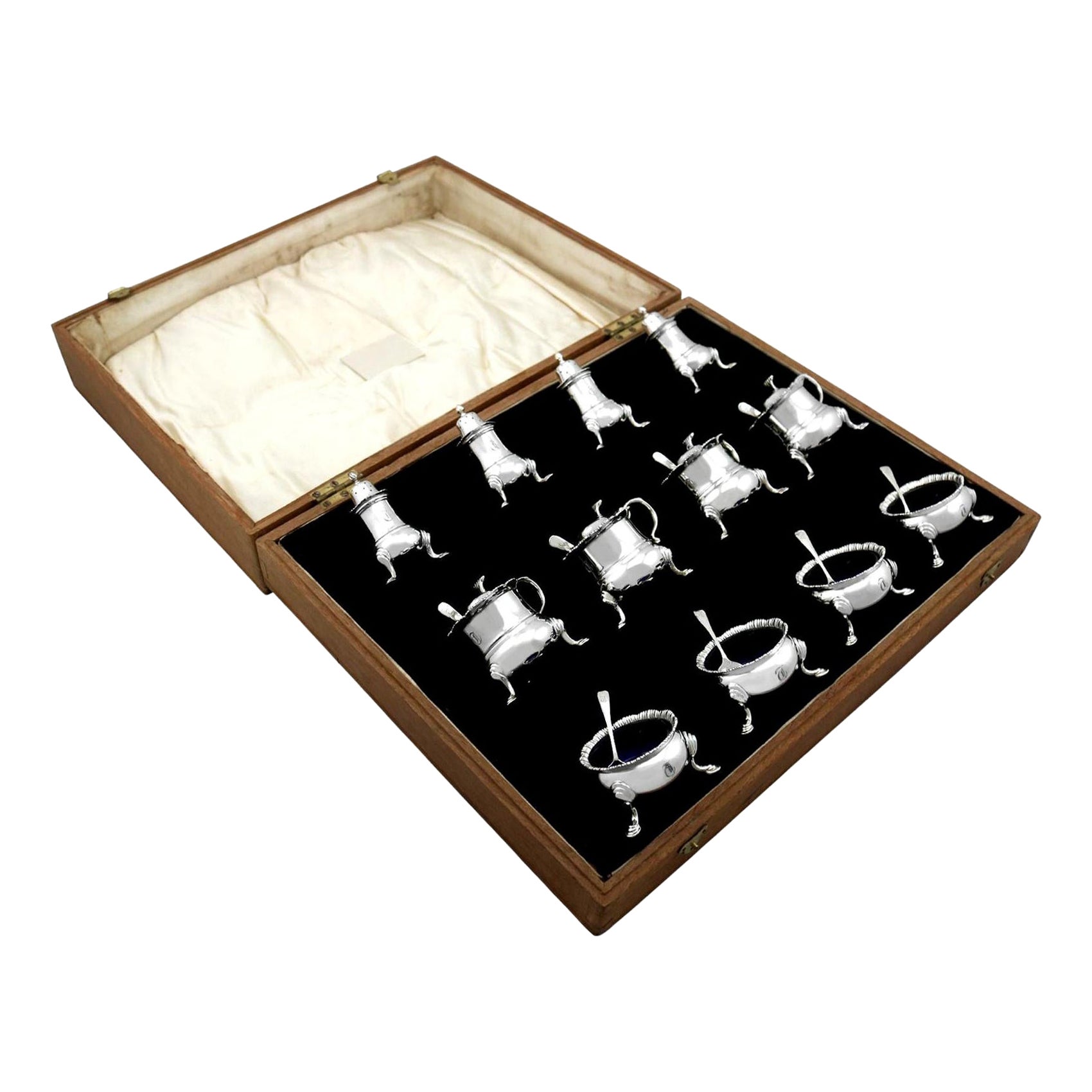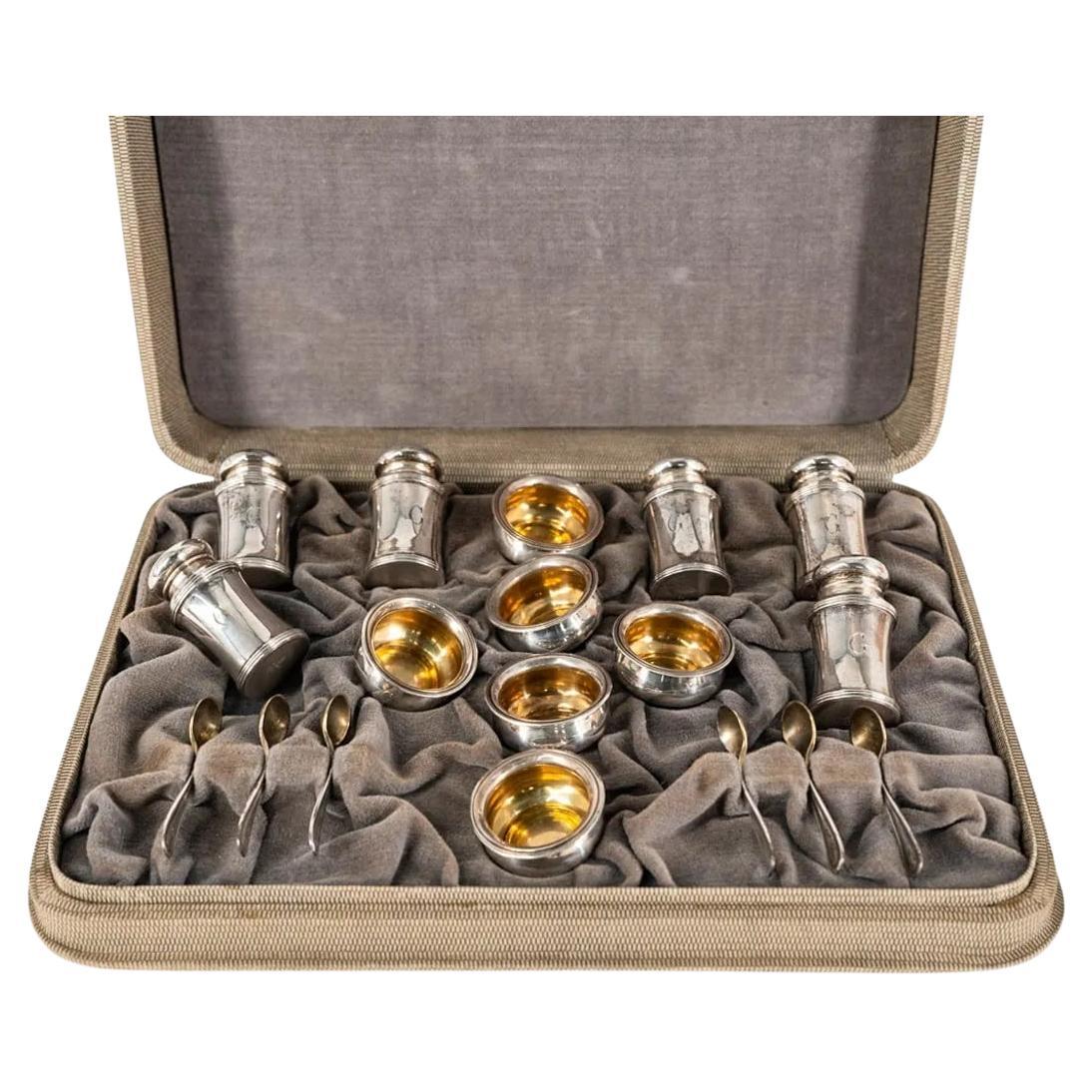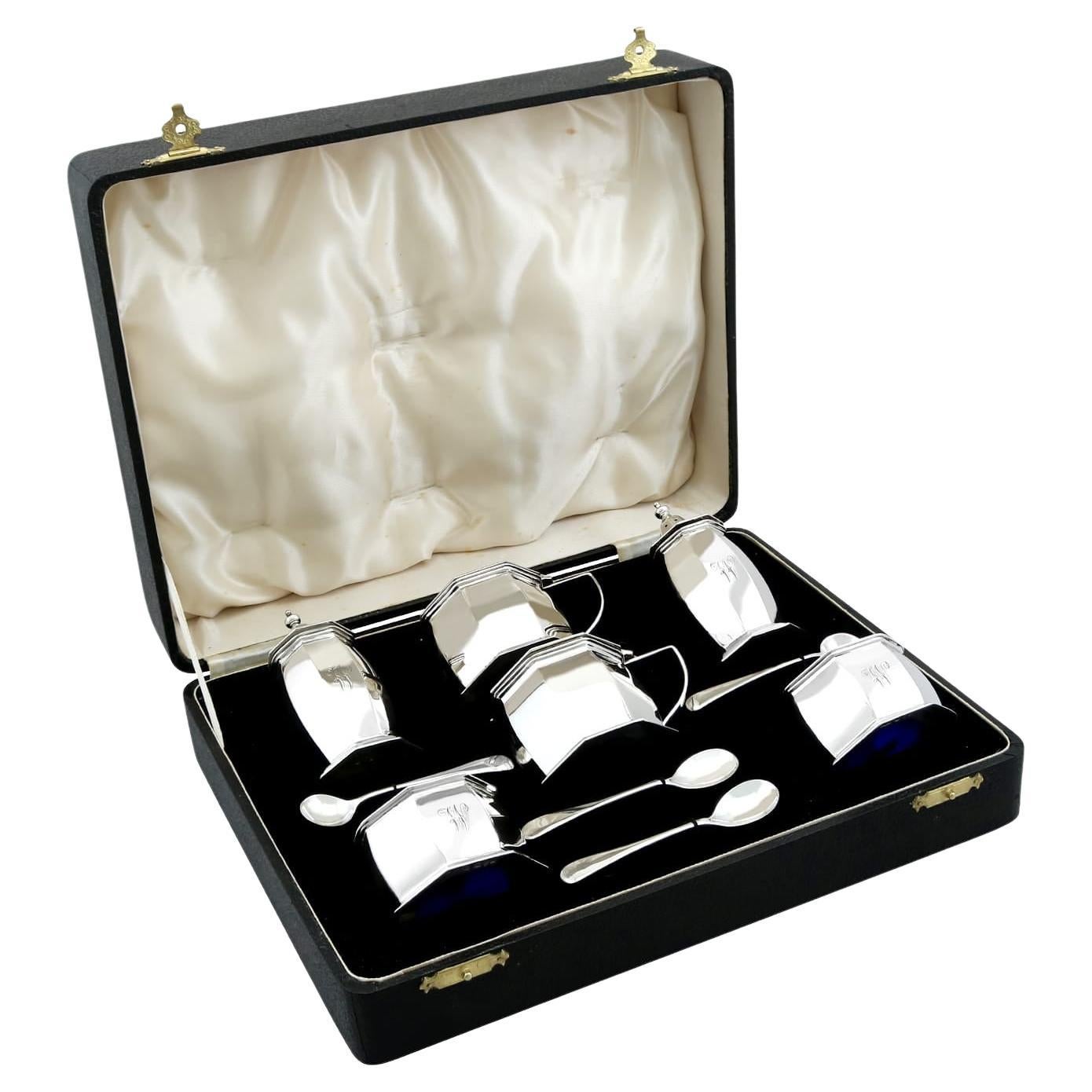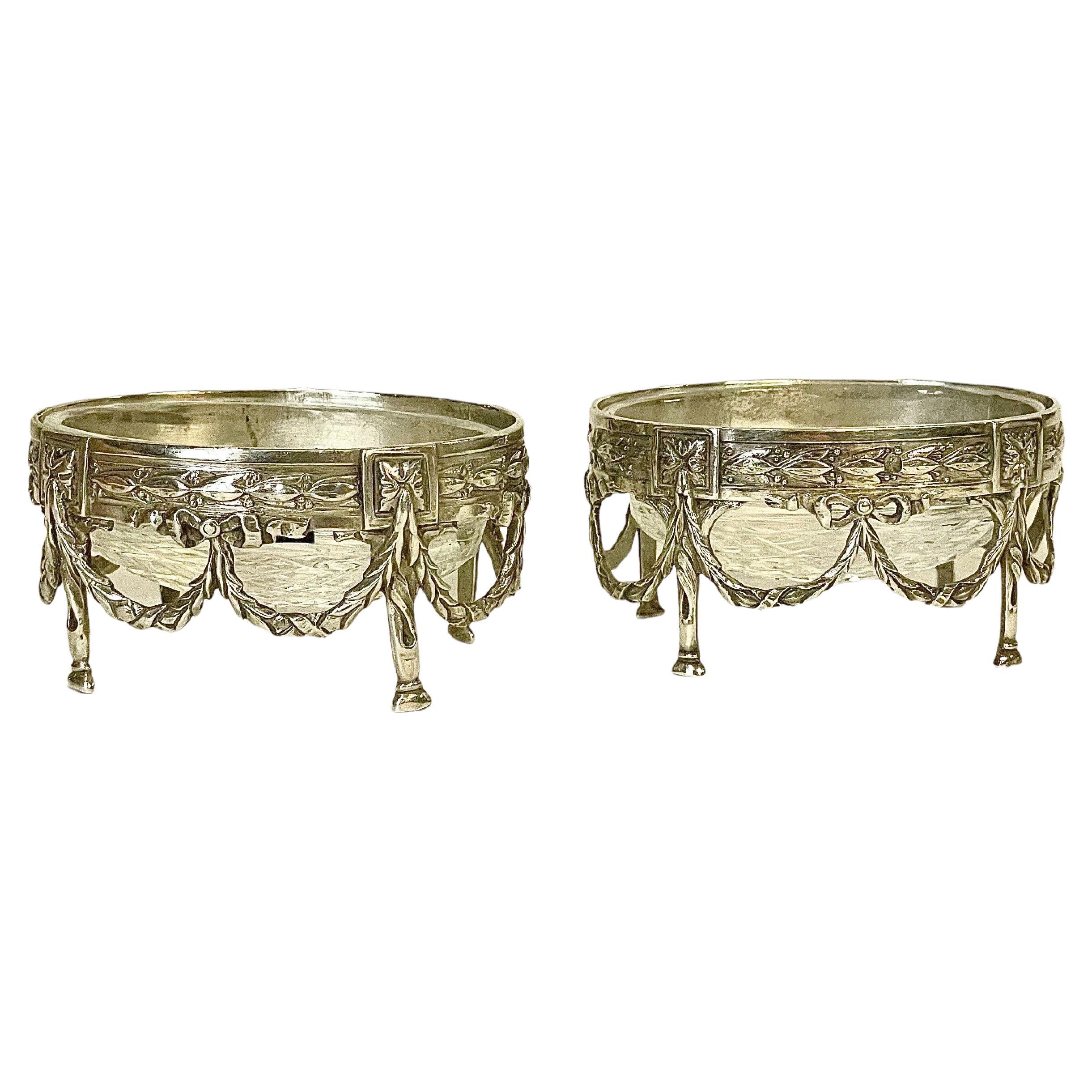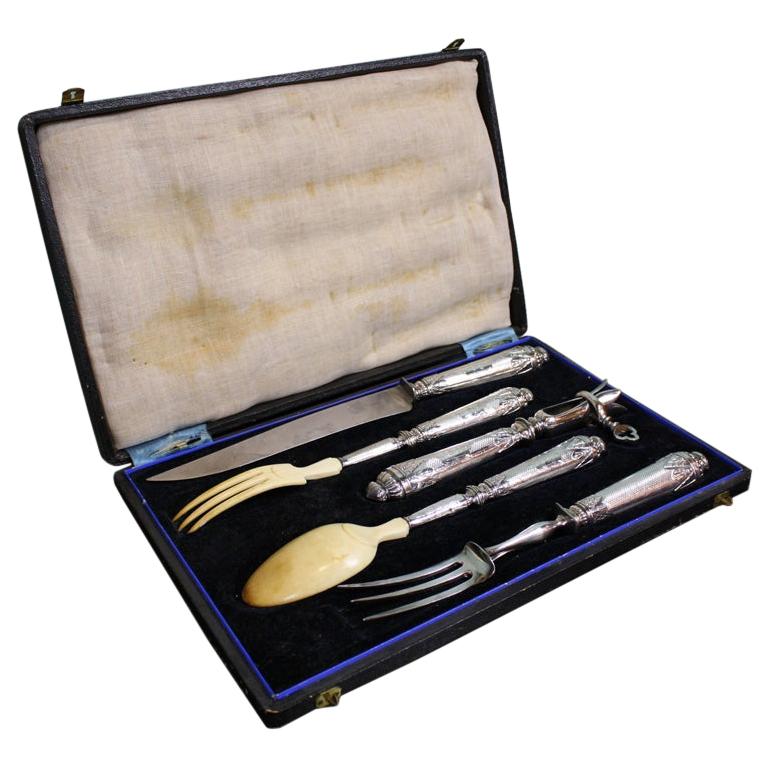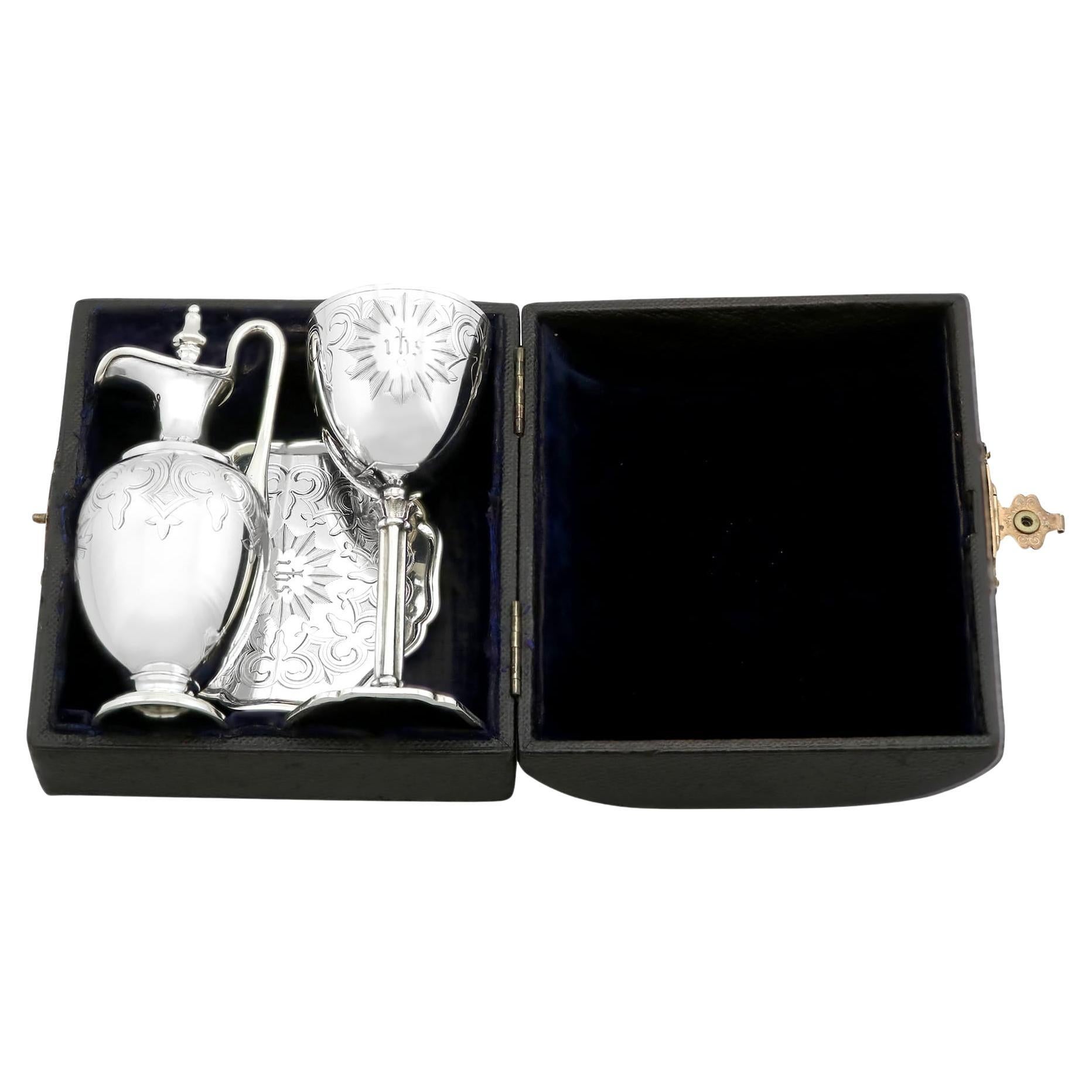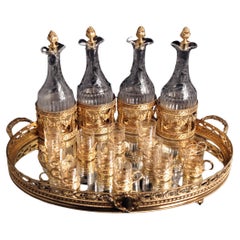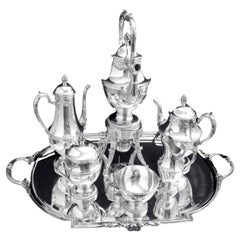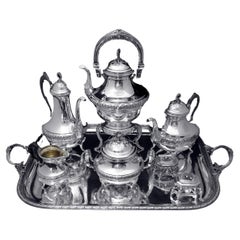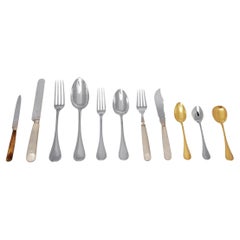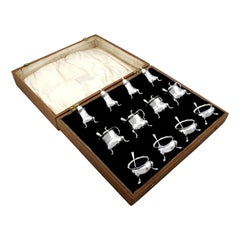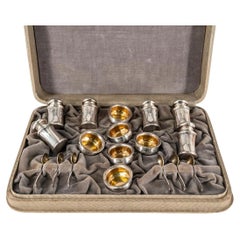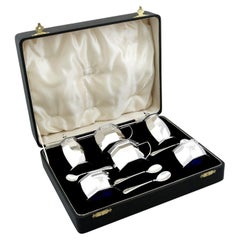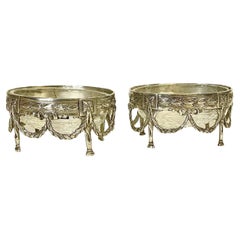Items Similar to Louis XVI - Original French 18th Century Sterling Silver Salt Cellars & Mustard
Want more images or videos?
Request additional images or videos from the seller
1 of 15
Louis XVI - Original French 18th Century Sterling Silver Salt Cellars & Mustard
$10,988per set
£8,265.29per set
€9,527.12per set
CA$15,477.82per set
A$16,982.85per set
CHF 8,888.03per set
MX$209,001.36per set
NOK 111,975.89per set
SEK 104,882.11per set
DKK 71,137.98per set
About the Item
Direct from a chateau in the south of France, a magnificent privately commissioned, 18th century 7pc table set of gorgeous original Louis XVI salt cellars (2 double and 4 single) and an equally elegant covered mustard server, each with their cobalt blue glass interiors, includes the original custom made storage chest, circa late 1700s - STUNNING. The 18th century in France, particularly under the reign of Louis XVI, was a period of significant artistic and cultural development. The era is marked by a refinement in decorative arts, including furniture, porcelain, and particularly silverware. Louis XVI sterling silver pieces, especially salt cellars and mustard servers, are exemplary of the period's craftsmanship and artistic sensibilities.
The Louis XVI period (1774-1792) coincided with the last years of the French monarchy before the Revolution. This era was marked by a return to classical aesthetics inspired by the discoveries of ancient Roman and Greek art. This Neoclassical movement influenced architecture, interior design, and the decorative arts, including silverware. The Louis XVI style is characterized by symmetry, straight lines, and classical motifs such as fluting, garlands, acanthus leaves, and medallions. These elements were a departure from the Rococo style of the previous Louis XV period, which favored more elaborate and asymmetrical designs. The shift reflected a broader societal move towards simplicity, order, and enlightenment ideals. The quality of Louis XVI sterling silver pieces is a testament to the superior materials and techniques employed by French silversmiths of the time. French sterling silver, an alloy containing 95.0% silver 5.0% other metals (usually copper), was favored for its durability and luster. This high silver content made the pieces not only beautiful but also resistant to tarnish and wear.
Silversmiths employed various techniques to create intricate designs and ensure the durability of their pieces. These techniques included casting, chasing, engraving, and gilding. Casting allowed for the creation of detailed three-dimensional forms, while chasing and engraving were used to add fine details and decorative patterns. Gilding, the application of a thin layer of gold, was often used to highlight specific areas of the design, adding contrast and luxury. Louis XVI silver pieces often featured classical design elements, meticulously executed by skilled artisans. Salt cellars and mustard servers, although small in size, displayed the same attention to detail and artistic sensibility as larger items. The precision and skill required to execute these designs were considerable, reflecting the high standards of French silver-smithing during the Louis XVI period.
Salt cellars and mustard servers were essential components of the 18th-century dining table. Salt was a valuable commodity, and its presentation in finely crafted silver cellars underscored its importance. Mustard, a popular condiment, was similarly presented in elegant servers. These items not only served practical purposes but also demonstrated the wealth and sophistication of their owners. Louis XVI salt cellars often featured circular or oval shapes, supported by tripod bases with intricate feet. The rims were frequently adorned with reeded bands or delicate beading. The interiors were sometimes gilded to prevent corrosion from the salt. Many salt cellars included classical motifs such as laurel wreaths, acanthus leaves, and medallions. Some were embellished with small handles in the form of animal heads or classical figures. Mustard servers typically comprised a lidded pot with a spoon. The lids were often domed, with finials shaped like acorns, pinecones, or urns. The bodies were decorated with fluting, garlands, and sometimes engraved monograms or coats of arms. The servers frequently featured neoclassical elements such as fluted columns, festoons, and rosettes. The handles and spoons were often intricately detailed, showcasing the silversmith’s skill.
The craftsmanship of Louis XVI silver pieces did not go unnoticed during the period. French silversmiths were often recognized at exhibitions and received various accolades for their work. The French silver trade was regulated by powerful guilds, which maintained high standards for craftsmanship and authenticity. These guilds provided a framework for training and certifying silversmiths, ensuring that only the best quality pieces were produced. Membership in a guild was a mark of prestige and often required demonstrating exceptional skill and creativity.
The French royal court was a significant patron of the arts, including silver-smithing. Louis XVI and his queen, Marie Antoinette, were known for their lavish lifestyle and appreciation for fine objects. They commissioned numerous pieces of silverware for use at court, setting trends that were emulated by the aristocracy. Salt cellars and mustard servers were among the many items produced for the royal household. These pieces often bore the royal monogram or coat of arms, serving as symbols of the monarch's taste and refinement. The royal patronage not only provided financial support to the silversmiths but also enhanced their prestige and visibility. Other influential patrons included high-ranking nobility and foreign dignitaries. The taste for Louis XVI silver extended beyond France, with pieces being commissioned by and gifted to royalty and aristocrats across Europe. This international appreciation further cemented the status of French silversmiths as leaders in the field.
The legacy of Louis XVI sterling silver pieces, particularly salt cellars and mustard servers, is one of enduring beauty and exceptional craftsmanship. These objects are now highly sought after by collectors and museums, appreciated for their historical significance and aesthetic qualities. The Neoclassical style of Louis XVI silver had a lasting impact on decorative arts. Its emphasis on classical forms and restrained elegance influenced subsequent design movements, including the Empire style of the early 19th century. The techniques and standards established during the Louis XVI period continued to inform the practice of silver-smithing in France and beyond.
Today, Louis XVI silver pieces are prized by collectors and often fetch high prices at auctions. Preserving these items requires careful attention to prevent tarnish and damage. Museums and private collectors invest in specialized care to maintain the condition of these historical artifacts. The Louis XVI period in France was a golden age for silverware, characterized by exceptional quality and craftsmanship. Salt cellars and mustard servers from this era exemplify the artistic and technical achievements of French silversmiths. Recognized with numerous awards and supported by royal patronage, these pieces continue to be celebrated for their beauty and historical significance. As objects of both utility and art, they reflect the elegance and sophistication of 18th-century French culture, leaving a lasting legacy in the world of decorative arts.
The First Double Salt Cellar Stands Approximately 14cm. High and Roughly 15cm. Across at its Widest Point. The Individual Salt Cellars are Roughly 8cm. Long and 5.50cm. Wide. The Unit Weights 303 grams With the Cobalt Blue Interiors and 123 grams Without the Interiors. 18th Century Sterling Silver Hallmarks are Stamped on the Underside of Each of the Individual Salt Cellars (see hallmark diagram below). The Second Double Salt Cellar Also Stands Approximately 14cm. High and Roughly 15cm. Across at its Widest Point. The Individual Salt Cellars are Also Roughly 8cm. Long and 5.50cm. Wide. The Unit Weights 308 grams With the Cobalt Blue Interiors and 124 grams Without the Interiors. 18th Century Sterling Silver Hallmarks are Stamped on the Underside of Each of the Individual Salt Cellars (see hallmark photo). The First Set of Single Salt Cellars - Each Salt Cellar Stands Roughly 4.50 cm High and Approximately 8.50 cm Long. One is 5.50 cm. Across at it Widest Point and the Other is Approximately 5.0 cm. Across at Its Widest Point. One Weights 180 grams with Its Cobalt Blue Glass Interior and 36 grams Without. The Other Weights 127 grams With Its Cobalt Blue Glass Interior and Also 36 grams Without the Interior. 18th Century Sterling Silver Hallmarks are Stamped on the Underside of Each of the Individual Salt Cellars (see hallmark photo). The Second Set of Single Salt Cellars - Each Salt Cellar Stands Roughly 5.00cm. High and Approximately 7.20cm. Long. Each are Approximately 5.50cm. Across at Their Widest Point. One Weights 123 grams with Its Cobalt Blue Glass Interior and 33 grams Without. The Other Weights 126 grams With Its Cobalt Blue Glass Interior and Also 33 grams Without the Interior. 18th Century Sterling Silver Hallmarks are Stamped on the Underside of Each of the Individual Salt Cellars (see hallmark photo). The Elegant Covered Mustard Server, Also with Cobalt Blue Glass Interior, Stands Approximately 10.00 cm. in Height and Measures Roughly 10.00 cm. Across to the Tip of the Handle. It as has a Diameter of just over 6.00 cm, Weights 251 grams with the Cobalt Blue Glass Interior and 111 grams Without. 18th Century Sterling Silver Hallmarks are Stamped on the Underside of the Mustard Server (see hallmark photo). The Custom Made Storage Chest Measures Approximately 36.80cm. Long, 24.50cm. Wide and 10.50cm. Deep. It has an Inlaid Brass Carrying Handle on the Lid, but the Key for the Chest is Not Included.
- Attributed to:France" (Manufacturer)
- Sold As:Set of 7
- Style:Louis XVI (Of the Period)
- Materials and Techniques:
- Place of Origin:
- Period:
- Date of Manufacture:1790s
- Condition:Refinished. Each piece has been professionally refinished.
- Seller Location:Wilmington, DE
- Reference Number:1stDibs: LU9583240243112
About the Seller
No Reviews Yet
Vetted Professional Seller
Every seller passes strict standards for authenticity and reliability
1stDibs seller since 2023
6 sales on 1stDibs
- ShippingRetrieving quote...Shipping from: Paris, France
- Return Policy
Authenticity Guarantee
In the unlikely event there’s an issue with an item’s authenticity, contact us within 1 year for a full refund. DetailsMoney-Back Guarantee
If your item is not as described, is damaged in transit, or does not arrive, contact us within 7 days for a full refund. Details24-Hour Cancellation
You have a 24-hour grace period in which to reconsider your purchase, with no questions asked.Vetted Professional Sellers
Our world-class sellers must adhere to strict standards for service and quality, maintaining the integrity of our listings.Price-Match Guarantee
If you find that a seller listed the same item for a lower price elsewhere, we’ll match it.Trusted Global Delivery
Our best-in-class carrier network provides specialized shipping options worldwide, including custom delivery.More From This Seller
View AllOdiot - 17pc Napoleon III Gold Plated Sterling Silver (Vermeil) Decanter Set
By Odiot
Located in Wilmington, DE
Direct from a Private Chateau in the South of France, A Magnificent 17pc. 19th Century Gold Plated 950 Sterling Silver (Vermeil) Napoleon III Liqueur Serving Set by the World's Premi...
Category
Antique 1890s European Napoleon III Barware
Materials
Gold Plate, Sterling Silver
$17,943 Sale Price / set
20% Off
Free Shipping
Keller - 8pc. Louis XVI 19th Century 950 Sterling Silver Tea Set, Museum Quality
By Gustave Keller Freres
Located in Wilmington, DE
Keller 8pc. Tea Set – Description
Direct from Paris, A Gorgeous 19th Century Louis XVI, 8 pc. 950 Sterling Silver Tea / Coffee Set by one of France's Premier Silversmiths, Gustave Keller, Includes a Large Sterling Silver Serving Tray...
Category
Antique 1890s French Louis XVI Tea Sets
Materials
Sterling Silver
$33,239 / set
Free Shipping
Boulenger - 8pc. Louis XVI, Silver Tea Set - Museum Quality !
Located in Wilmington, DE
Direct from Paris, A Superb 8 piece 19th Century Louis XVI Sterling Silver Tea Set by the one of France's Premier Silversmiths "Adolphe Boulenger" in...
Category
Antique 1870s French Louis XVI Tea Sets
Materials
Sterling Silver
Aucoc - 166pc. Antique French 950 Sterling Silver & Vermeil Flatware Set + Chest
By A. Aucoc
Located in Wilmington, DE
Direct from Paris, A Magnificent 166pc. 950 Sterling Silver and Vermeil Flatware Set by Andre Aucoc "Silversmith to the Kings and Queens of Europe...
Category
Antique 1890s French Louis XVI Sterling Silver
Materials
Vermeil, Sterling Silver
Odiot - 6pc. Antique French Sterling Silver Tea Set, Like New Condition, 1890s !
By Odiot
Located in Wilmington, DE
Direct from Paris, a stunning 6pc. silver tea set by one of France’s premier silversmiths “Odiot”, professionally refinished to like new condition and with no monograms on any of the...
Category
Antique Late 19th Century French Louis XVI Tea Sets
Materials
Silver Plate, Sterling Silver
$13,492 / set
Free Shipping
Caron - 197pc. Antique French 950 Sterling Silver & Vermeil Flatware Set, Marly
By Olier & Caron 1
Located in Wilmington, DE
Direct from Paris, A Magnificent 197 Piece, 19th Century, Louis XVI Model, Sterling Silver Flatware Set with 8 Serving Pieces and 10 Covered Individual Anti-Tarnish Storage Trays by Renowned French Silversmiths "Henri Soufflot...
Category
Antique Late 19th Century French Louis XVI Sterling Silver
Materials
Gold Plate, Vermeil, Sterling Silver
$24,093 Sale Price / set
30% Off
Free Shipping
You May Also Like
Antique George V English Sterling Silver Condiment Set
Located in Jesmond, Newcastle Upon Tyne
An exceptional, fine and impressive, comprehensive antique George V English sterling silver twelve piece condiment / cruet set - boxed; an addition to our dining silverware collection
This exceptional antique George V twelve piece boxed silver condiment set, in sterling standard, consists of four salts, four pepper pots and four mustard pots.
The pieces of this fine comprehensive antique condiment set...
Category
Vintage 1930s British Serving Pieces
Materials
Sterling Silver
6 Wilcox & Wagoner Sterling Salt Cellars, Pepper Shakers, Salt Spoons by Watson
By Wilcox and Wagoner
Located in Miami, FL
Set of six Art Deco sterling silver open salt cellars, salt spoons and pepper shakers made by Watson Company for Wilcox and Wagoner, circa 1905-1929. The salt cellars and spoons are ...
Category
Vintage 1920s American Art Deco Sterling Silver
Materials
Sterling Silver
Antique George V Sterling Silver Condiment Set
Located in Jesmond, Newcastle Upon Tyne
An exceptional, fine and impressive, antique George V English sterling silver six piece condiment/cruet set - boxed; an addition to our Chester silverware collection.
This exception...
Category
Vintage 1930s English Sterling Silver
Materials
Sterling Silver
$2,206 / set
Pair of Sterling Silver and Cut Crystal Salt Cellars
Located in LA CIOTAT, FR
An exquisite pair of Louis XVI-style cauldron-shaped, sterling silver salt cellars, finely decorated with swags and motifs of asparagus and laurel wreaths.
Dating from around the t...
Category
Early 20th Century French Louis XVI Sterling Silver
Materials
Crystal, Silver
Antique French .950 Silver 5-Piece Carving Service with Gigot in Box
Located in Pembroke, MA
A finely-chased French .950 fine silver five-piece carving service comprising a caving knife, a carving fork (with adjustable resting stand for raising it off of the table), a serving fork with bone tines, a serving spoon with bone bowl, and a handle for holding a leg of lamb ("manche a gigot...
Category
Antique 19th Century French Napoleon III Sterling Silver
Materials
Silver
Antique Victorian Sterling Silver Communion Set (1863)
By George John Richards & Edward Charles Brown
Located in Jesmond, Newcastle Upon Tyne
An exceptional, fine and impressive antique Victorian English sterling silver communion set - boxed; an addition to our diverse religious silverware collection.
This exceptional ant...
Category
Antique 1860s English Victorian Sterling Silver
Materials
Sterling Silver
More Ways To Browse
Antique French Kitchen
Lyon Antique
French Louis Xvi Oval Dining Table
Metal Table Greek Key
1700s Chest
French 18th Century Household Items
Large Copper Pot With 2 Handles
Mustard Pot Silver Cobalt
Cobalt Glass Sterling Silver Salt Cellar
Antique Salt Server
Sterling Silver Pheasants
Sterling Silver Rooster
Sterling Stag
Tea Spoons Gold
Tiffany Shaker
Tiffany Sterling Silver Vine Pattern
Wallace Rose Point
Wallace Sterling Silver Rose Point
